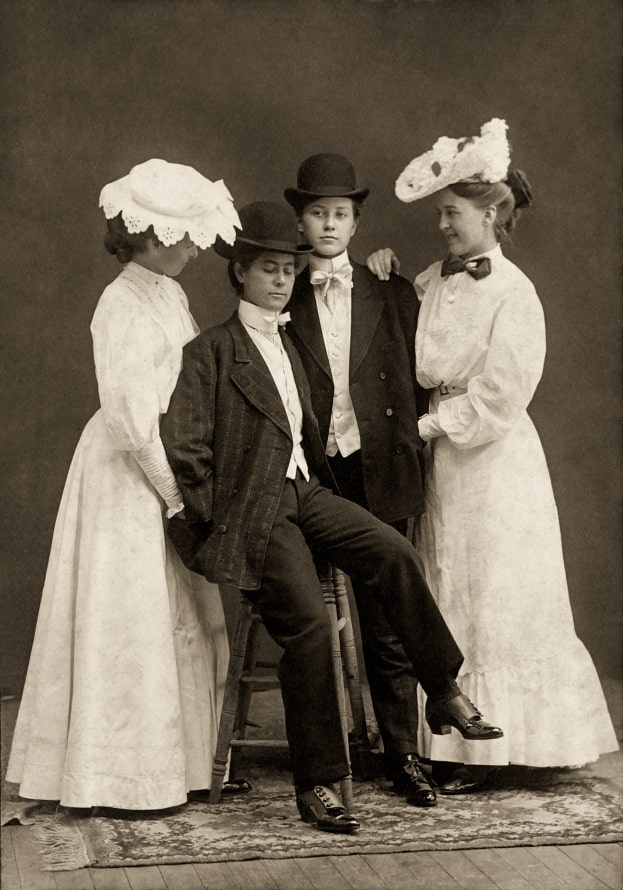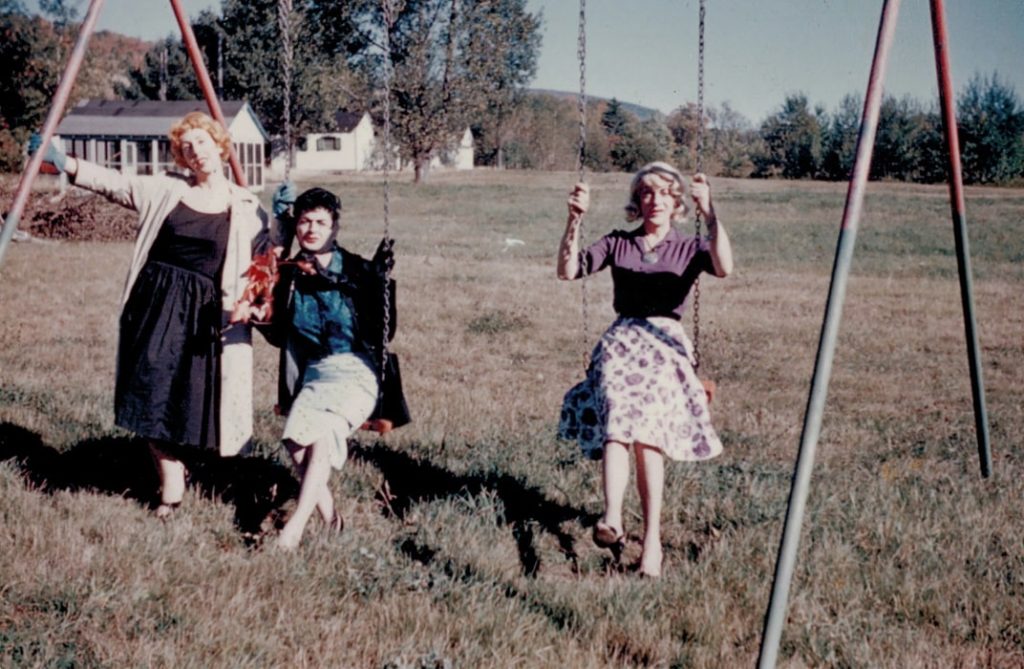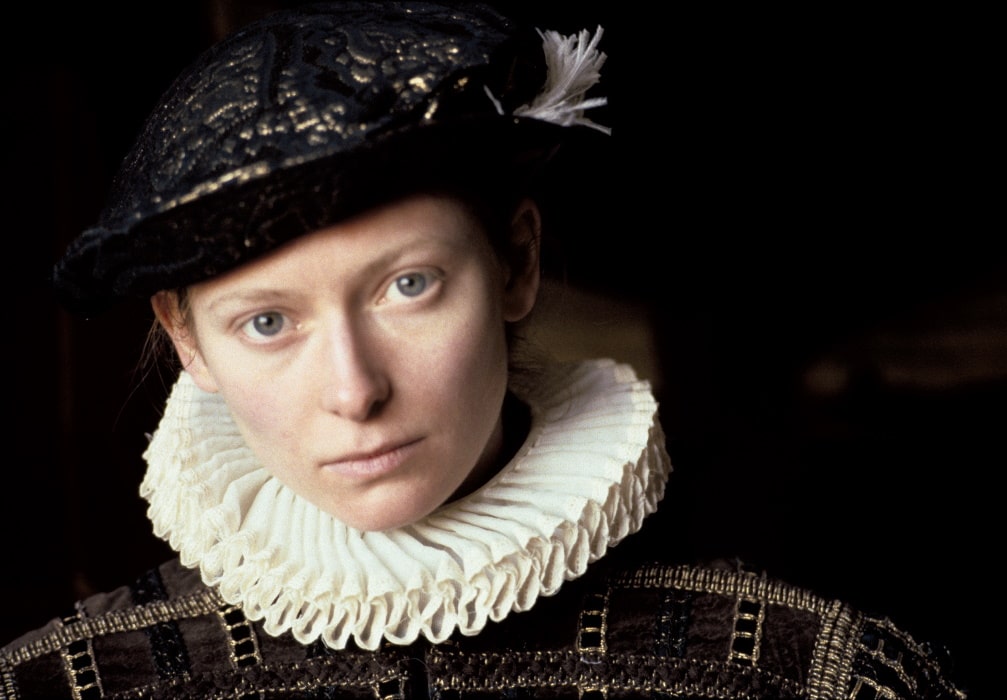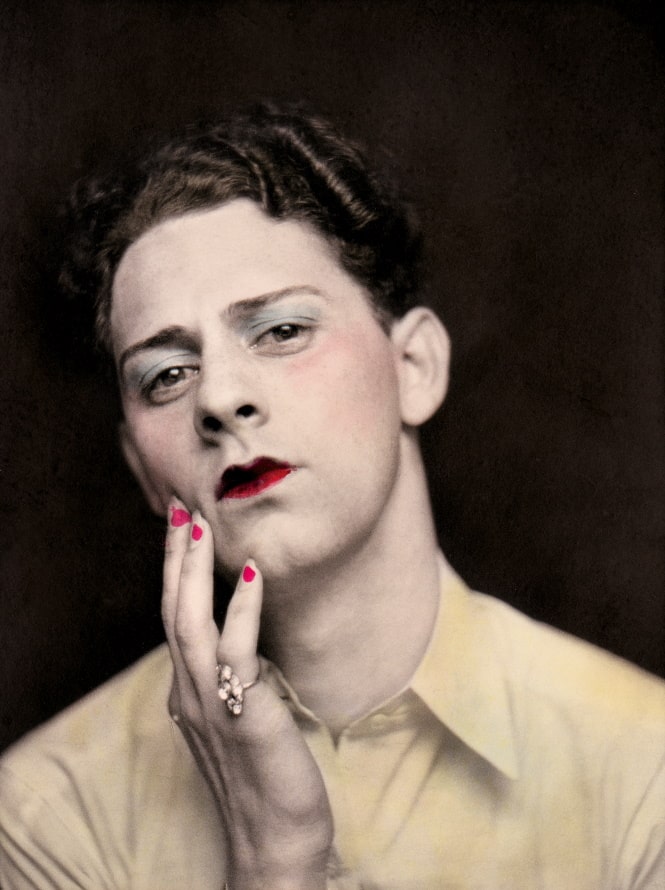Slightly tilted to the side, a young man gazes gracefully into the camera, rouge shimmers delicately on his prominent cheekbones, his lips glisten in a seductive red, while light blue eye shadow shines delicately over the eye area. His fingers with pink painted nails gently touch the right cheek of the half-portrait, a ring is prominently stuck on the little finger. Or is it not the supposed image of a woman after all? Can we even decide on the basis of gender-specific visual codes which identity a person has? C/O Berlin presents the exhibition Queerness in Photography from 17 September 2022 to 18 January 2023.
Image above: Anonymous, Untitled, USA, ca. 1930. Sébastien Lifshitz Collection
In three complementary exhibitions (Under Cover . A Secret History of Cross-Dressers . Sébastien Lifshitz Collection | Casa Susanna . Cindy Sherman Collection | Orlando . Curated by Tilda Swinton), C/O Berlin’s Queerness in Photography explores the photographic representation of identity, gender and sexuality: from historical imagery showing the act of photographing as an act of identity-making, to a unique safe space in photographic history, to contemporary expressions of gender fluidity that raise the question of whether socially constructed genders are still relevant today. For since its invention in 1839, photography has not only depicted people, but has also significantly shaped their socio-political position by visually categorising people based on physical characteristics, behaviour or clothing. By inscribing constructed gender roles, it also became a medium of stigmatisation and discrimination. Just as the current discourse on the rights of the LGBTQIA+ community around the world continues to evolve, and concepts and issues are continually renegotiated, so too has the photographic vocabulary for visually representing queerness multiplied.
The three exhibitions on Queerness in Photography reveal a multi-layered panorama and show that photography can also be an act of liberation and self-empowerment. By visualising one’s own identity or documenting communal cohesion in the queer community, new artistic forms of representation emerge.

C/O Berlin is showing Under Cover . A Secret History of Cross-Dressers . Sébastien Lifshitz Collection, the collection of amateur photographs assembled over several decades by the French filmmaker Sébastien Lifshitz. Since the 1860s, people have used the medium to question their gender identity ascribed by clothing or physical characteristics.
Without knowing the respective histories or personal motivations, these portrayals reveal the desire of those portrayed to explore themselves in front of the camera: in addition to rebelling against imposed social expectations and political regulations, they make themselves aware of their own identity in the photographically produced self-portrait.
Divided into several chapters, the Lifshitz collection not only spans 120 years of queer forms of representation, but also locates worldwide phenomena such as cross-dressing in the cultural history of the performing arts, such as theatre or cabaret. Alongside androgynous people in suits, the early pioneers of RuPaul’s extravagant drag queens or women who marry other women in mock weddings, Under Cover . A Secret History of Cross-Dressers . Sébastien Lifshitz Collection a variety of visual representations of feminism, LGBTQIA+ rights, trans identity and the liberalisation of sexuality. In this way, the historical visual material also visually anticipates the social progress that has only been achieved because people have behaved non-conformist or defied the binary attributions of gender conventions. The visual evidence of the Lifshitz Collection is thus one of the more significant discoveries in recent photographic history, filling a void in cultural memory.

With Casa Susanna . Cindy Sherman Collection, the world’s most famous dress-up artist presents original Casa Susanna images from her own collection. “I found the Casa Susanna photos in a scrapbook that was sold at an antique flea market in New York City about 17 years ago. The scrapbook itself wasn’t worth saving, but the photos excited me,” Sherman explains about her historic discovery. Casa Susanna was a safe space for cross-dressers and trans women in Hunter, New York in the 1950s and 1960s. Within this small community, members could explore their identities together – at a time when life plans, sexuality and gender outside heteronormative ideas and conventions were stigmatised or even prosecuted. The act of taking photographs within this community was of the highest social explosiveness, as the members visually documented what was not allowed to be at that time: a life outside socially constructed gender roles as well as a personality development based on their own needs.
The imagery of Casa Susanna not only reveals the cohesion and solidarity within this community, but also a light-heartedness and cheerfulness inscribed in the images, which came into being precisely because people were able to develop freely there.
At the same time, these visual traces of Casa Susanna – due to a decades-long social taboo on topics such as transidentity, sexuality and cross-dressing – continue to possess a mysterious character, as the protagonists and creators can no longer bear witness to their intentions themselves.
Rather, these images confront us today with questions about sexuality and identity: Is a man in drag gay? When does a woman become a woman in a photograph? And who decides on the criteria? We as viewers?
In interaction with the Lifshitz Collection, a queer image archive is thus being created at C/O Berlin that, due to its uniqueness and identity-creating character, must also be preserved and valued by future generations.

In 1992, actress Tilda Swinton played the gender-nonconforming lead in the award-winning film Orlando (directed by Sally Potter), based on Virginia Woolf’s 1928 novel of the same name. Woolf’s novel tells the story of a young aristocratic person who lives for centuries. Without ageing, the novel’s character is able to mysteriously change gender. “I see Orlando as a story about the life of a person who strives to free himself completely from the constructs of gender or social norms,” Swinton describes the subject matter.
Her androgyny in the film contributed to her image as one of the most versatile actress:es of her generation and definitively established her as an icon in the LGBTQIA+ community. Behind the foil of the book and film, Swinton has put together the exhibition Orlando for C/O Berlin on behalf of Aperture magazine.
Gender fluidity and the idea of a borderless consciousness interweave here in a new way within the exhibition.
The works, some of which were conceived especially for Orlando . Curated by Tilda Swinton present different perspectives on questions of identity, gender, origin and sexuality. In the diversity of artistic approaches and perspectives, common ideas, forms of representation and power relations are broken up.
Through the selection of the artists, their artistic reinterpretation of the themes and the identity-creating construction of new narratives, previously marginalised or underrepresented perspectives are given a stage. The visual reflection of human existence in its diversity is at the same time an inspiring plea for impartiality, empathy and tolerance in contemporary artistic photography.
The exhibition shows the works of the artists : Zackary Drucker, Lynn Hershman Leeson, Paul Mpagi Sepuya, Jamal Nxedlana, Elle Pérez, Walter Pfeiffer, Sally Potter, Viviane Sassen, Collier Schorr, Mickalene Thomas und Carmen Winant.
WHEN?
Exhibition Saturday, 17. September 2022 – Wednesday, 18. January 2023
Opening Friday, 16. September 2022, 8:00 pm
open daily 11:00 am – 8:00 pm
COSTS?
Admisson fee 10 Euro, reduced 6 Euro
WHERE?
C/O Berlin Foundation
Amerika Haus
Hardenbergstraße 22–24
10623 Berlin-Charlottenburg
SOCIAL MEDIA
www.facebook.com/coberlinphoto
www.instagram.com/coberlin
www.twitter.com/coberlin
#coberlin #queernessinphotography #collectionlifshitz #cindysherman #orlandoexhibition






